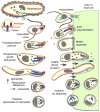Evolution of apicomplexan secretory organelles
- PMID: 23068912
- PMCID: PMC3583008
- DOI: 10.1016/j.ijpara.2012.09.009
Evolution of apicomplexan secretory organelles
Abstract
The alveolate superphylum includes many free-living and parasitic organisms, which are united by the presence of alveolar sacs lying proximal to the plasma membrane, providing cell structure. All species comprising the apicomplexan group of alveolates are parasites and have adapted to the unique requirements of the parasitic lifestyle. Here the evolution of apicomplexan secretory organelles that are involved in the critical process of egress from one cell and invasion of another is explored. The variations within the Apicomplexa and how these relate to species-specific biology will be discussed. In addition, recent studies have identified specific calcium-sensitive molecules that coordinate the various events and regulate the release of these secretory organelles within apicomplexan parasites. Some aspects of this machinery are conserved outside the Apicomplexa, and are beginning to elucidate the conserved nature of the machinery. Briefly, the relationship of this secretion machinery within the Apicomplexa will be discussed, compared with free-living and predatory alveolates, and how these might have evolved from a common ancestor.
Copyright © 2012 Australian Society for Parasitology Inc. Published by Elsevier Ltd. All rights reserved.
Figures

References
-
- Allen RD, Fok AK. Membrane trafficking and processing in Paramecium. Int Rev Cytol. 2000:198. - PubMed
-
- Barta JR, Thompson RC. What is Cryptosporidium? Reappraising its biology and phylogenetic affinities. Trends Parasitol. 2006;22:463–468. - PubMed
-
- Billker O, Dechamps S, Tewari R, Wenig G, Franke-Fayard B, Brinkmann V. Calcium and a calcium-dependent protein kinase regulate gamete formation and mosquito transmission in a malaria parasite. Cell. 2004;117:503–514. - PubMed
Publication types
MeSH terms
Grants and funding
LinkOut - more resources
Full Text Sources

